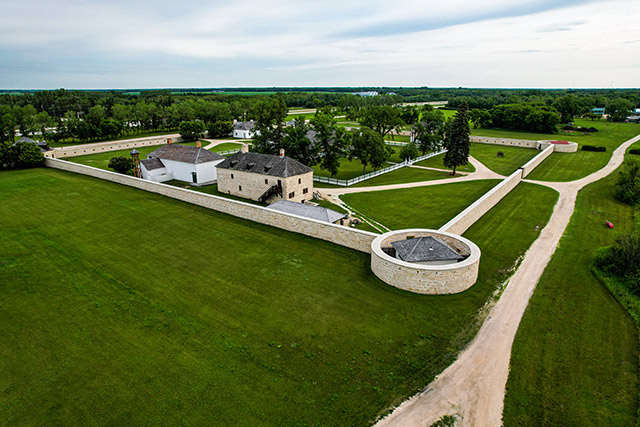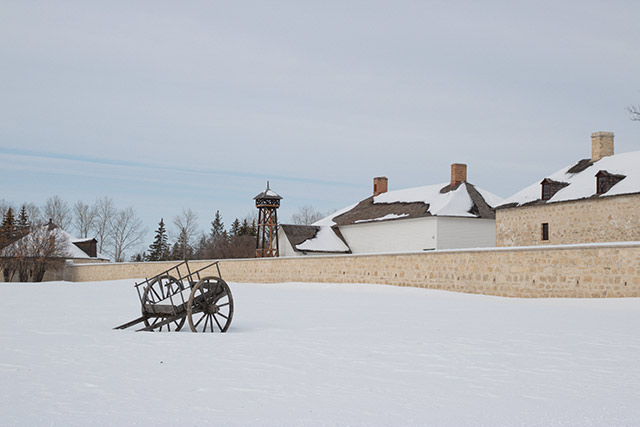Lower Fort Garry National Historic Site had its future set in stone from the moment the first block was laid. The thick walls and bastions of the fur trading fort are constructed from Tyndall Stone. This material set the fort apart from most other posts across the country both then and now.

What is Tyndall Stone?
Tyndall Stone is limestone that has fossil fragments in it. The tapestry-like look comes from the marine organisms that lived at the bottom of a sea that once covered Manitoba, the only place Tyndall Stone is quarried. In January 2023, the International Union of Geological Sciences designated it as a global heritage stone resource, making it the only Canadian stone on the worldwide list.
In Canada, Tyndall Stone has been used at the parliament buildings in Ottawa, the Canadian Museum of History in Quebec, and the legislative buildings in Regina and Winnipeg. Overseas, it’s in London, England’s Canada House, the Canadian Embassy in Berlin, and private homes across Australia and Japan.
Why Tyndall Stone?

The social significance of stone buildings versus wood appealed to Sir George Simpson, Governor of the Hudson’s Bay Northern Department. Simpson constructed the fort as the company’s administrative centre. He had grand plans for Lower Fort Garry and spared no expense to make it look as impressive as he possibly could. The decorative nature of Tyndall Stone certainly fit the bill.
For many prominent citizens within the Red River settlement – especially senior HBC officers and independent merchants – the style, size, and architectural sophistication of their homes, churches, and forts were an expression of privilege. Simpson’s choice to build Lower Fort Garry out of stone was meant to give the new fort an air of “civilization.” It also befitted his plans for it to serve as a home for himself and his young English wife.

Stone buildings also had an air of permanence. Virtually all buildings constructed by European traders between Lake Superior and the Pacific Ocean were made of wood. This was largely due to its availability, but also because of the often-temporary nature of many posts. The challenge of stone construction was only undertaken at a few locations where the material was available or where the Hudson’s Bay Company desired the permanence and defensive posture represented by stone walls and bastions. Prince of Wales Fort, the oldest stone fort in Western Canada, set at the mouth of Manitoba’s Churchill River is another example of this.
How was it used at Lower Fort Garry?

Tyndall Stone was discovered in 1823 by Hudson's Bay Company employees who first noticed an exposure along the banks of the Red River.
The stone was often quarried in the spring and then transported to the building site where it was worked, or shaped, by masons. A windlass lifted the rough-cut slabs onto Red River carts, which were pulled by oxen to the top of the bank and transported to the building site. [1] After working the stone, the masons began the painstaking task of setting the blocks. Depending upon available labour, this could be a slow process. The walls at Lower Fort Garry took almost 10 years to build.
Some of the stone quarried around the fort was reduced for use as mortar, whitewash, and in fertilizer. For this purpose, kilns were built. The first kiln was probably built in the early 1830s, perhaps near the stone quarry on the riverside in front of the Big House. In 1861, there was at least one kiln and a shed for storing the finished product. These facilities, along with the proximity of good quantities of limestone, made Lower Fort Garry the main supplier of lime for all the posts in the HBC’s Red River District.
The survival of Lower Fort Garry more or less intact illustrates the strength and durability of Tyndall Stone as a building material, along with its ability to solidify history.
[1] A windlass was a mechanical device that consisted of a roller or beam, resting upon supports, around which a rope or chain was wound. The limestone blocks were then lifted onto the cart and with block and tackle were raised in place on the walls of the fort. Robert Watson in his book, Lower Fort Garry: A History of the Stone Fort, alternatively argued the stone was cut and moved via sleds and oxen during the winter months.
- Date modified :